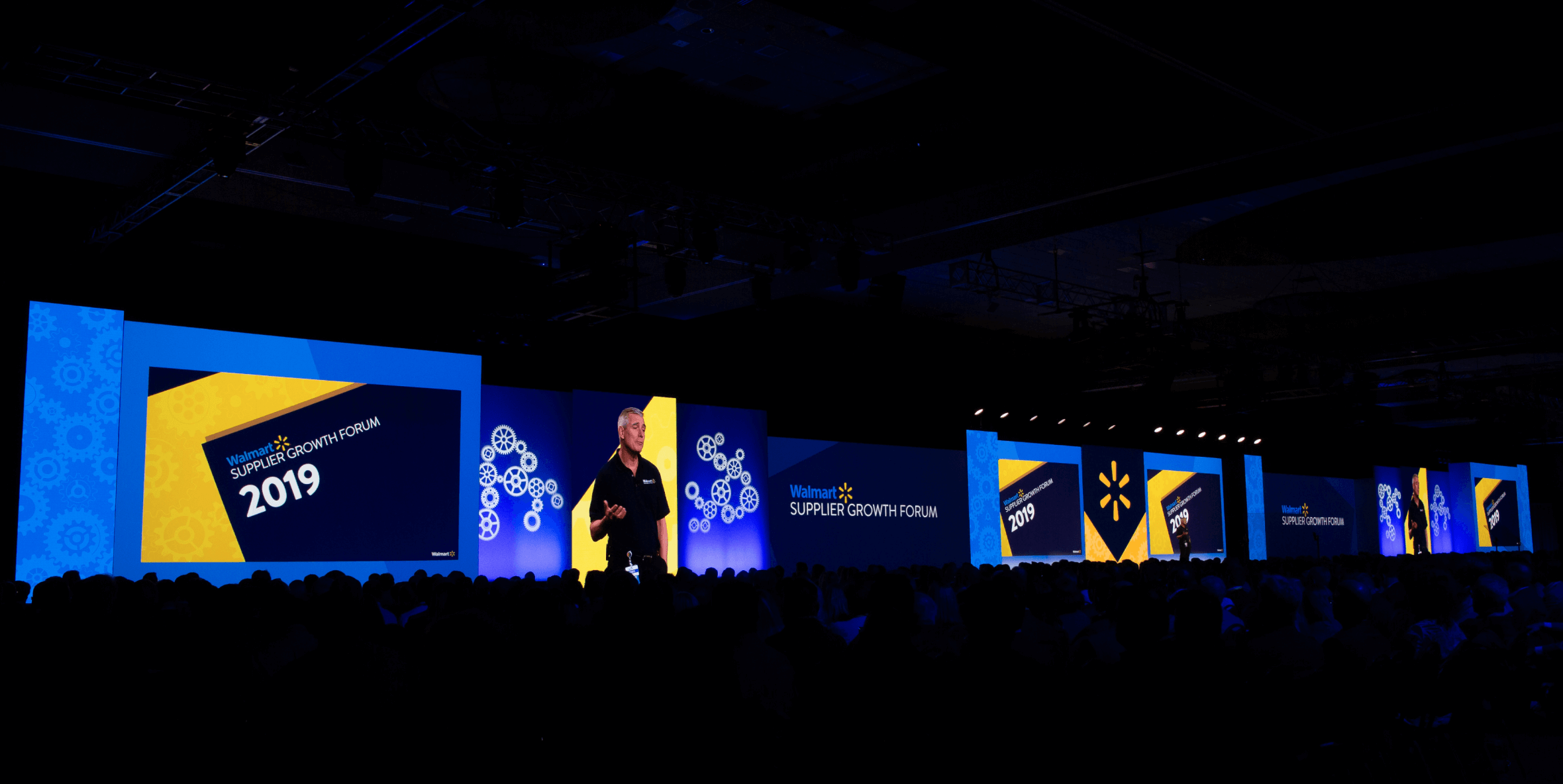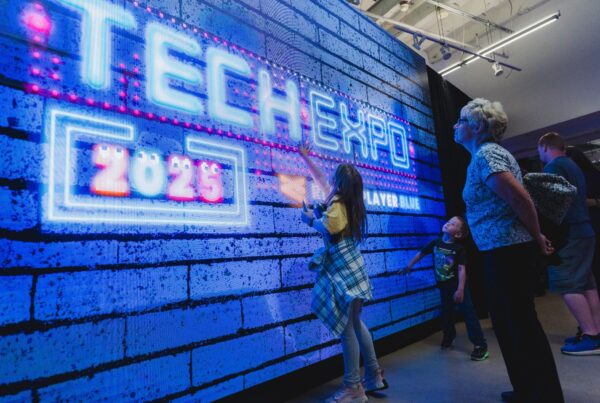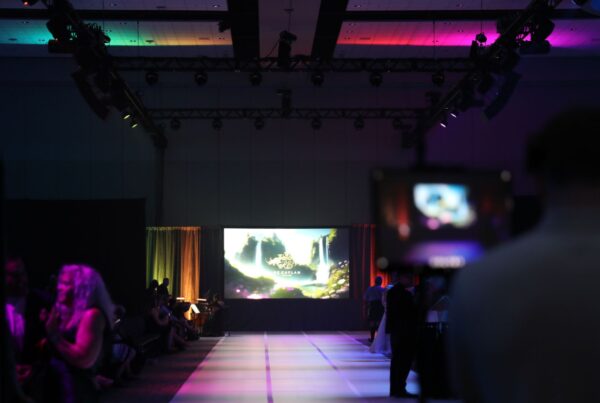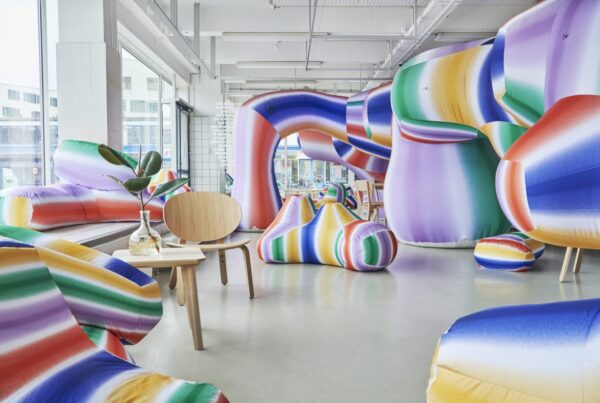Here’s how technology is shaping the future of large-scale events, creating more engaging, efficient, and unforgettable experiences for attendees and organizers alike.
Immersive Visual Experiences
AV technology has brought visual storytelling to the forefront of event design. With tools like projection mapping, LED video walls, and dynamic digital signage, event organizers can now turn blank spaces into vibrant, immersive environments. These technologies allow event spaces to be transformed with custom content—whether it’s a trade show booth showcasing a brand’s journey through a stunning 3D projection or a conference stage wrapped in LED displays that sync with presentations in real time.
By creating visually compelling experiences, AV technology can help capture attention, maintain engagement, and ensure that the brand’s message resonates long after the event ends.
Interactive Presentations and Keynotes
Gone are the days of static slideshows and passive listening. AV capabilities are transforming how presentations are delivered, making them more engaging and interactive. Speakers can now use multi-screen displays, interactive polls, and real-time data visualization to keep the audience engaged. Large video walls that wrap around a stage can be synchronized with content to create an immersive experience that feels less like a lecture and more like a visual journey.
Audience engagement tools, such as live polling, interactive Q&A sessions, and feedback collection, allow attendees to participate actively, making them feel more involved in the event and the conversation. These technologies foster a deeper connection between presenters and their audiences, resulting in a more impactful and memorable session.
Personalized Attendee Engagement
AV technology greatly enhances personalization at large events like trade shows and conferences by tailoring interactions and content to individual preferences. Smart name badges, interactive touchscreens, and digital signage work together to provide customized content and recommendations based on attendees’ interests and behaviors. For instance, digital displays can show relevant session information or exhibitor details when an attendee checks in or interacts with various touchpoints.
Artificial Intelligence (AI) further elevates personalization by analyzing attendee data in real time to deliver tailored suggestions and alerts. Interactive maps, personalized agendas, and real-time feedback mechanisms ensure that attendees receive a customized experience, making it easier to navigate the event and engage with content that is most relevant to them. These features create a more engaging and memorable event experience by adapting to individual needs and preferences.
Enhanced Networking Opportunities
Advanced audiovisual equipment can significantly enhance networking experiences at large events by providing interactive and seamless environments that facilitate connections. Smart name badges, integrated with AV technology, display relevant attendee information when people meet, making introductions smoother and conversations more meaningful. This feature helps attendees quickly understand who they are connecting with, fostering more relevant and productive interactions.
Interactive networking lounges equipped with AV tools offer digital touchpoints where attendees can search for and connect with others who share similar interests or professional backgrounds. These lounges often include video call stations and interactive displays that help attendees find and engage with relevant contacts. For virtual or hybrid events, AV technology supports face-to-face networking through video calls and virtual meeting rooms, breaking down geographical barriers and making connections with distant contacts easier.
AI-driven audiovisual tools can provide real-time connection suggestions based on attendee interactions and preferences, while interactive digital boards allow participants to post messages, share ideas, and seek connections on various topics. Integrated event apps provide real-time updates and notifications about networking opportunities, ensuring that attendees are always aware of relevant events and contacts.
Efficient Event Management
AV capabilities significantly enhance efficient event management at large-scale events by streamlining various processes and improving overall coordination. Digital kiosks and self-service check-in stations equipped with AV technology expedite the registration process, reducing wait times and providing attendees with immediate access to event information and directions. This ensures a smooth and efficient start to the event, setting a positive tone for the experience.
Interactive digital maps and wayfinding displays further facilitate efficient event management by helping attendees navigate large venues with ease. These features offer real-time updates on session locations, exhibit halls, and amenities, minimizing confusion and allowing attendees to quickly find their way around. High-quality audio systems and digital signage also play a crucial role in centralized communication, broadcasting announcements, schedule changes, and important updates to all attendees instantly.
AV tools enable dynamic schedule management, allowing for real-time updates to agendas and session timings. This flexibility ensures that attendees are always informed of the latest changes and can adjust their plans accordingly. Enhanced data collection and analysis capabilities also contribute to efficient management by providing organizers with valuable insights into attendee interactions and feedback, helping to optimize operations and address any issues promptly.
Increased Accessibility
AV technologies significantly enhance accessibility at large-scale events by incorporating features that cater to various needs and ensure inclusivity for all attendees. Assistive listening devices, such as FM systems, infrared systems, and hearing loops, amplify sound and transmit it directly to hearing aids or headsets, making presentations and discussions more accessible to those with hearing impairments. Real-time closed captioning and subtitles displayed on screens further support attendees who are deaf or hard of hearing by making spoken content visible and comprehensible.
Audiovisual tools help facilitate the inclusion of sign language interpreters into live streams and presentations, providing essential support for attendees who use sign language. For international events, real-time language translation through multilingual audio channels or subtitling helps non-native speakers by breaking down language barriers and ensuring they can fully engage with the event. Interactive wayfinding displays and kiosks assist those with mobility impairments by providing information about accessible routes and facilities, while accessible digital content features, like screen readers and adjustable text sizes, ensure that all attendees can easily access event information.
Conclusion
AV technologies are revolutionizing large-scale events like trade shows and conferences by enhancing personalization, streamlining management, and improving accessibility. These technologies enable event organizers to deliver more engaging and inclusive experiences, from dynamic content delivery and interactive networking to efficient event coordination and assistive features. By embracing AV innovations, organizers not only meet the growing expectations of attendees but also set new standards for what is possible in event management. As technology continues to evolve, the role of AV features will become even more integral, shaping the future of events and ensuring they are both impactful and accessible for all participants.
Looking to elevate your next large-scale event? Discover how Bluewater can transform your trade show or conference with advanced technology that enhances personalization, networking, and accessibility. Contact us today to see how we can help you create an unforgettable experience for all attendees!












